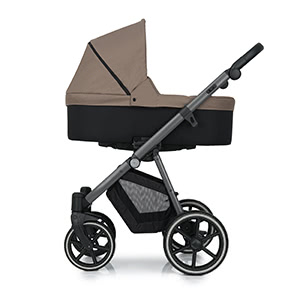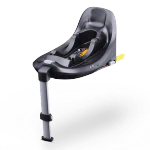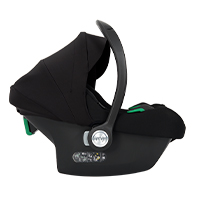
The Maternity Record | my junior® Pushchair

Everything you need to know about the maternity record.
Are you pregnant and looking for the right pram for you and your little one? From modern all-rounders to retro prams. In our pram overview you'll find all the important information at a glance.
The maternity record is far more than just a document – it accompanies you on the exciting journey through your pregnancy. It records all the important information about your health and that of your baby, serves as a guide for the coming months, and gives you the reassurance of always being well informed.
But what do all these technical terms mean? Which entries are particularly important? This guide will help you to better understand your maternity record, so that you can keep track at all times. With easy-to-understand explanations, practical tips, and caring advice, we want to support you, so that you can enjoy your pregnancy feeling relaxed and full of joyful anticipation.
What information can you find in the maternity record?
The maternity record booklet accompanies you throughout your pregnancy and contains all important information concerning your health and that of your baby. From the first check-ups and blood tests to ultrasound results – the maternity record documents the entire course of the pregnancy and serves as an information source for you and your medical team. You should bring it with you to every check-up so that all results can be recorded.
Why is the maternity record so important for your pregnancy?
In Germany, the maternity record is a legally recognised document (provided by the G-BA) which is issued to you by your gynaecologist after your pregnancy has been confirmed. Please note that the issuance of your record may also take place at a later stage of your pregnancy—depending on your gynaecologist. In any case, it should be issued no later than the 12th week of pregnancy.
It helps doctors and midwives to better understand the course of the pregnancy and to detect possible complications at an early stage. It also provides you with a good overview of your pregnancy and allows you to track the development of your baby.
What is documented in the maternity record?
The maternity record book documents all information regarding the course of your pregnancy. This includes your personal details, information about your health, as well as all results from your antenatal check-ups. These cover ultrasound scans, blood tests, and specific tests for possible infections. Should complications arise or you require medical assistance while out and about, medical staff can immediately access the relevant information using the maternity record book. This ensures prompt and targeted care, which can be life-saving for you and your child.
Maternity record booklet page 1: Personal details and doctor's stamp
On the first page of the maternity record, your midwife, doctor’s surgery or clinic responsible for your care is entered, along with their stamp and contact details. This information helps to quickly identify the attending doctor in case of an emergency. Additionally, the dates for your next appointments can be recorded here.
Maternity Record Book Pages 2-3: Laboratory Tests
Here is space for your own contact details and various other personal information. In addition, your blood group is recorded on the second page. This is important in case blood transfusions need to be administered.
During your pregnancy, you will often have to provide urine samples at the gynaecologist’s practice. The results of the urine tests are then recorded on the third page of your maternity record. For example, your urine will be tested for chlamydia right at the beginning of your pregnancy. If you do have a chlamydia infection, you will need to take antibiotics, as chlamydia increases the risk of miscarriage.
Also on page 3 of your maternity record you will find the LSR test. LSR is the abbreviation for Lues Screening Reaction. Lues, or syphilis, is nowadays extremely rare. However, the test is important because an infection can have serious complications for both mother and child. The result of the test is not recorded in the maternity record, only that it has been carried out.
The result of the HIV test is also not entered in the maternity record, only the fact that it has been carried out. The HIV test is recommended for all pregnant women, but it is voluntary. A counselling session usually takes place beforehand.
Between the 24th and 27th week of pregnancy, a follow-up test for irregular antibodies is carried out; the result is also recorded on page 3.
The test for HBs antigen is only carried out in the 32nd week of pregnancy. It indicates a hepatitis B infection. If you are infected with the pathogens that cause hepatitis, your child will be vaccinated immediately after birth.
In the 36th week of pregnancy, a test for a Group B streptococcal infection is carried out. A test for toxoplasmosis is only performed if there is a justified suspicion, as a primary infection during pregnancy can cause damage to the child's eyes and brain.
Rhesus factor
It is important to determine the Rhesus factor in order to rule out a blood group incompatibility between mother and child. This can occur if a Rhesus-negative mother is expecting a Rhesus-positive baby. If the blood of the mother and child come into contact during birth or an amniocentesis, the blood without the Rhesus factor would form antibodies against the Rhesus-positive blood of the baby and attack it. This is rather rare, as only 15 percent of Europeans have a negative Rhesus factor. In the past, this used to be very dangerous, but fortunately that is no longer the case. As a rule, all Rhesus-negative mothers are routinely given the anti-D serum in the 28th week of pregnancy. This prevents the formation of antibodies.
Rubella HAI test
On the second page of your maternity record, you will also find the result of the rubella HAH test. The rubella antibody test is usually only carried out if you have not been vaccinated against rubella twice. It checks whether you have antibodies against the rubella virus in your blood. Although rubella is a harmless childhood illness, it can be very dangerous for the foetus in the womb. Most pregnant women have already had the illness or were vaccinated as children. If two rubella vaccinations are documented, the test can be omitted. If the test is negative, you must absolutely avoid contact with people who are infected with rubella. Unfortunately, vaccination is no longer possible during pregnancy.
Maternity Record Book Page 4: Previous Pregnanciesn
Here it is noted whether you have ever been pregnant before. Possible complications during the birth of your first child are also recorded. Miscarriages, ectopic pregnancies or premature births are also entered here. This information is important in order to better assess possible risk factors for the current pregnancy.
Maternity Record Book pages 5-6: Findings and Risks
On these pages, the doctor or midwife documents potential health risks and specific findings concerning the pregnant woman. Chronic illnesses or medical histories that could affect the pregnancy are also recorded here.
At this point, you will also find the expected due date of your little bundle of joy. However, you can easily work it out yourself: Simply subtract three months from the first day of your last period, then add seven days and one year, and you will have your possible due date: First day of last period – 3 months + 7 days + 1 year.
Page 6 also records whether you smoke. Special circumstances such as gestational diabetes are also noted here.
Maternity Record Book Pages 7-9: Course of Pregnancy
These pages record the course of the pregnancy. Information on weight gain, blood pressure, uterine height and the baby’s heartbeat is regularly updated here. This allows doctors and midwives to keep an eye on the condition of both mother and child.
The gravidogram is a chart in which the results of various antenatal check-ups are recorded. It is essentially a list that, with the help of many abbreviations, documents both the development of the baby and your own development during pregnancy. All these abbreviations are bound to seem confusing at first glance. It’s not always possible to remember to ask about everything at each check-up. That’s completely normal, as every visit to the doctor with a baby in your tummy is something very special and also incredibly exciting. Here you’ll find an overview of the most important abbreviations:
GW: Gestational week
Fundal height: Distance between the upper edge of the uterus (fundus) and the pubic symphysis (symphysis)
Fetal position: this is where it is recorded how your baby is lying at the time of the examination: cephalic position (CP), transverse position (TP), breech position (BP).
- Oedema: Fluid retention
- Varicosis = varicose veins
- RR = blood pressure value
- Hb (erythrocytes) = blood pigment and number of red blood cells for the detection of anaemia
- Sediment: Urine examination
Vaginal examination: Examination of the vagina
Maternity Record Book pages 10-12: Ultrasound Examinations
Here all the information from your three major ultrasound scans will be recorded. The health insurance covers all three. Any additional scans you will have to pay for yourself. The first screening takes place between the 9th and 12th week, the second should be between the 19th and 22nd week, and the third between the 29th and 32nd week.
The size of the baby, the position and condition of the placenta, as well as the amount of amniotic fluid, are recorded in the process. This data helps to monitor the baby's development closely.
If any abnormalities are detected during the routine ultrasound examinations, your doctor may recommend further tests. These screenings are then also covered by your health insurance.
Important examinations and tests in the maternity record
Among the most important tests documented in the maternity record are the blood test for rhesus factor and blood group, as well as the test for rubella antibodies. These examinations help to prevent potential complications that may arise during pregnancy. The maternity record also provides an overview of the course of the pregnancy, including information about your weight, blood pressure, and the development of the baby.
Maternity Record Page 13: Standard Curves
Your doctor can enter the values from the ultrasound examination into the standard growth chart. This allows you to see how the baby develops over time. The calculated due date may also be corrected if necessary. The following values are entered into the chart:
CRL: Length of the child from crown to rump
BPD: Transverse diameter of the fetal head
ATD: Transverse diameter of the child's abdomen
Maternity Record Page 14: Double Ultrasound
Page 14 is reserved for the results of further ultrasound examinations. Doppler sonography is, so to speak, a more precise CTG. Here, the blood flow in the uterus and the baby's blood vessels is checked if there is suspicion of an illness or a possible malformation.
Maternity Record Book page 15-16: Summary
On the last two pages of your maternity record, everything is summarised once again at the end of your pregnancy. For example, it is recorded here how many ultrasound scans you have had.
Here, details about your baby's birth will also be recorded. For example, the course of the birth and the result of the Apgar test will be noted. This is a test that records your baby's breathing, pulse, muscle tone, skin colour, and reflex response immediately after birth.
At the end, information about the postnatal period is also recorded in your maternity record. For example, whether there were any complications. Six to eight weeks after giving birth, you will have another check-up with your gynaecologist.
Important tips about the maternity record from our my junior® midwife Sandra
It is very important that you always carry your maternity record with you. Nine months is a long time, so to ensure nothing happens to your maternity record, our my junior® midwife Sandra recommends getting a protective cover. It is important that this cover is washable. You will be taking your maternity record with you to the doctor and to all your other activities. A washable cover is therefore more hygienic than, for example, one made of felt.
Frequently Asked Questions about the Maternity Record Book
When will I receive my maternity record?
You will receive your maternity record as soon as the pregnancy has been confirmed. This is done by your gynaecologist or your midwife. Usually, the process goes like this: after you have your positive pregnancy test in hand, you can call your gynaecologist to make an appointment. Depending on how far along you are, you may have to wait a little while, and around the fifth week, the time finally comes. Your first appointment with the gynaecologist takes place, and once the pregnancy is officially confirmed, you will receive your maternity record.
What is an electronic maternity record?
Since the beginning of 2022, the maternity record has also been available in an electronic version (E-Mutterpass). It is then part of the electronic health card. This is practical because it means you automatically always have your maternity record with you. However, most mums still prefer to have something to hold in their hands. For example, you can give the maternity record to your child when they are grown up, or it simply serves as a lovely keepsake. However, it is important that you always take the maternity record with you when you are out and about.
What information is recorded in the maternity record?
The maternity record contains many important pieces of information, such as your state of health before and during pregnancy, blood values, results of ultrasound examinations, and tests for infectious diseases. Possible risk factors and the course of the pregnancy are also documented in it.
Do I always have to carry the maternity record with me?
It is advisable to always carry the maternity record with you, especially when visiting the doctor or in case of an emergency. This allows medical professionals to quickly and effectively access important information.
What happens if I lose my maternity record?
If you should lose your maternity record, there is no need to panic at first. Your doctor can issue a new record, with all previous examinations being copied from your medical files. Nevertheless, you should take good care of it.
What is the maternity record still important for after the birth?
Even after the birth, the maternity record can still be important, especially if there are any questions about the pregnancy or if you plan to have another child in the future. Doctors can use it to access relevant information.
Is the maternity record recognised in other countries?
In some countries, the German maternity record is recognised, but in many others it is not. It is important that you always carry the most important information with you in English when abroad. Some countries have their own forms that you need to fill in.
Can I keep my maternity record myself?
It is not customary for pregnant women to make entries in the maternity record themselves. The entries are made by doctors, midwives, and medical professionals.

 Pushchair
Pushchair  MAVI
MAVI  VIGO²
VIGO²  VITA unique³
VITA unique³  VIGO² Alcantara
VIGO² Alcantara  VIGO
VIGO  VITA HOPE
VITA HOPE  VITA unique²
VITA unique²  PICO³ with tub
PICO³ with tub NOAX²
NOAX²  MIYO²
MIYO²  Pram tests
Pram tests  Consultation
Consultation  Buggies
Buggies  PICO³
PICO³  PLIA²
PLIA²  PLIA² Air
PLIA² Air  PICO³⁶⁰
PICO³⁶⁰  PICO³ with tub
PICO³ with tub  PICO tub
PICO tub  PICO infant car seat adapter
PICO infant car seat adapter  Limited Editions
Limited Editions 











 VIGO
VIGO  VITA HOPE
VITA HOPE  Limited Edition Parasol
Limited Edition Parasol  Limited Edition Baby Carrier
Limited Edition Baby Carrier 
 VITA HOPE
VITA HOPE  Child seats
Child seats  All Isofix Bases
All Isofix Bases  AURAᵉʳᵍᵒ
AURAᵉʳᵍᵒ  Aura Pro
Aura Pro  Beam
Beam  Cyro 360
Cyro 360  Base 360
Base 360  Base Static
Base Static  Capsule System
Bundle
Capsule System
Bundle  Beam Bundle
Beam Bundle  Avionaut Cosmo
Avionaut Cosmo 
 Black Friday Sale
Black Friday Sale
 Reviews
Reviews  Read reviews
Read reviews  Write a review
Write a review 
 Home
Home  Fabric sample
Fabric sample  Baby carriers
Baby carriers  LUVA
LUVA  NAMI
NAMI  NAMI with ring
NAMI with ring  Accessories
Accessories  Vouchers
Vouchers  Discover my junior®
Discover my junior®  About us
About us  In your vicinity
In your vicinity  All my junior
All my junior Flagship Store
Aachen
Flagship Store
Aachen  Flagship Store
Hamburg
Flagship Store
Hamburg  Flagship Store
Salzburg
Flagship Store
Salzburg  Flagship Store Binzen
Flagship Store Binzen
 Flagship Store
Krefeld
Flagship Store
Krefeld  Studio Cologne
Studio Cologne  Studio Trier
Studio Trier  Studio Braunschweig
Studio Braunschweig
 Studio Metzingen
Studio Metzingen
 my junior® pram in
Switzerland
my junior® pram in
Switzerland  Help and Contact
Help and Contact  Useful
Useful  Career
Career  Press
Press 










